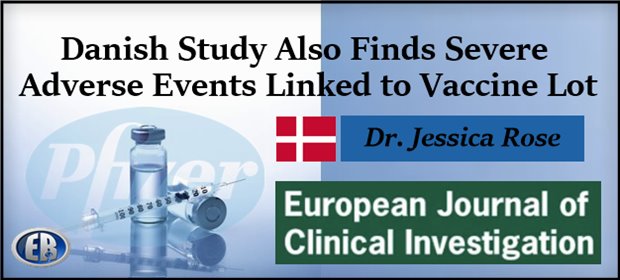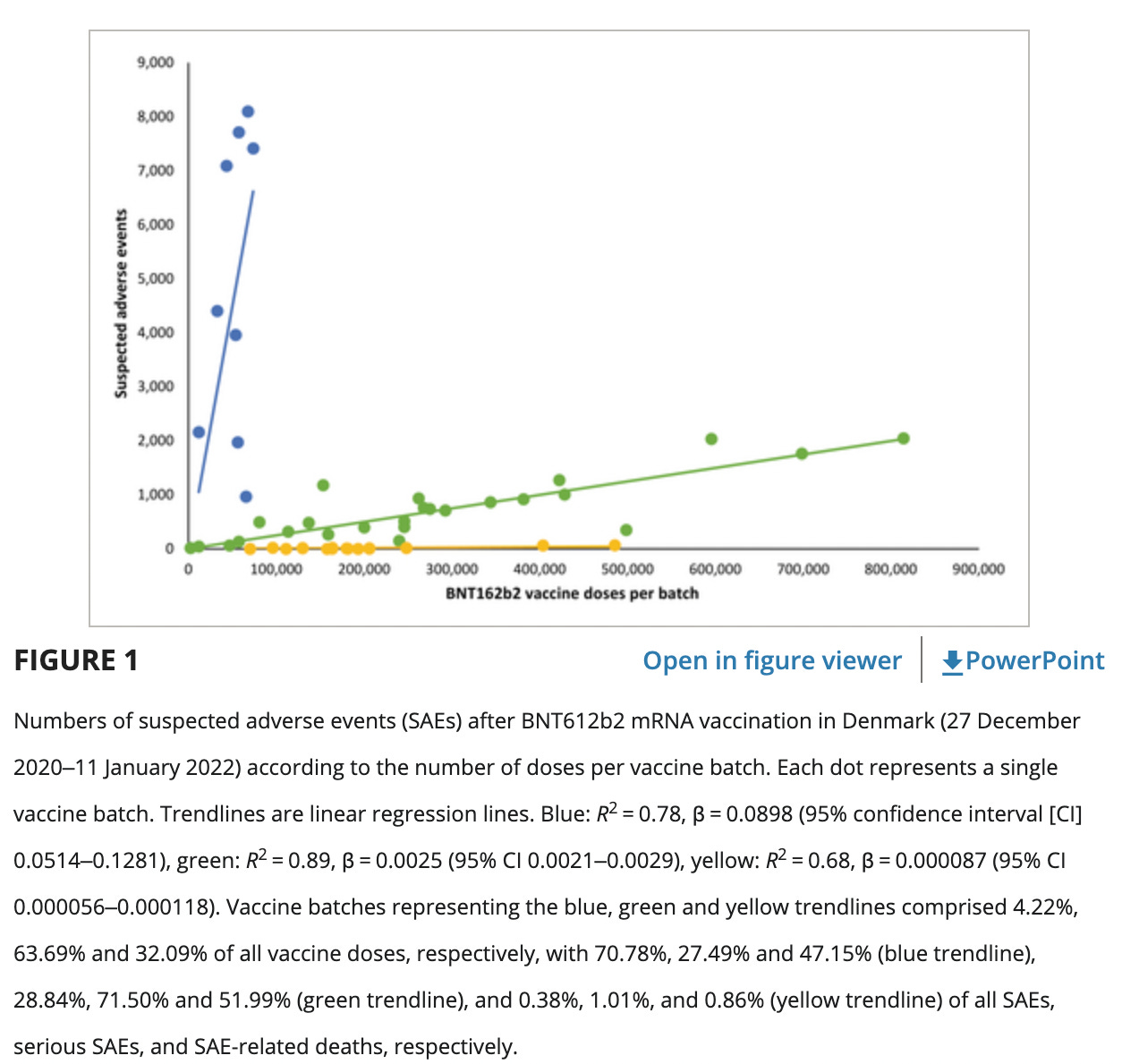
ER Editor: Dr. Jessica Rose, incidentally, does not look at the Covid vaccines from a point of view of their containing graphene oxide, toxic lipids and self-assembling nanoparticles. She only seems to deal with them as containing biological material, i.e. mRNA.
A reminder that around 18 months ago, in late 2021, just 5% of vaccine batches in the United States were found to be associated with 100% of adverse events. See
Exclusive: Have 100% of US Covid-19 Vaccine Deaths Been Caused by Just 5% of the Batches?

********
Danish study on lot variation and associations with SAEs
Thoughts and comments
The conclusion of this study is that, within the Danish population, of the people who got 2 doses of Pfizer mRNA product, their SAE occurrences were linked to the batch number of the product. They claim that further investigations of this lot-to-lot variation need to be done, and I couldn’t agree more. The manner in which this is done is important.
In conclusion, the results suggest the existence of a batch-dependent safety signal for the BNT162b2 vaccine, and more studies are warranted to explore this preliminary observation and its consequences.
The data comes from the Danish Medical Agency (DKMA) which is akin to VAERS in that it is a passive reporting system, and SAEs were classified as per the MedDRA coding system: same as VAERS.
Data for 3,748,215 people in the context of 52 different BNT162b2 vaccine batches, ranging from 2,340–814,320 doses per batch, was collected for batches ‘administered’ between December 27, 2020 and January 11, 2022 in Denmark. 7,835,280 doses were administered to these people so each is presumed to have received 2 doses. 43,496 SAEs were registered in 13,635 people. So the numbers are good. Plenty of data.
They plot their findings and it looks like this:

This is compelling, no doubt. It certainly looks like there are batches that have fewer doses but resulting in much higher incidence and reporting of SAEs, doesn’t it? There appear to be at least 4 batches associated with greater than 7,000 SAE reports with fewer than 100,000 doses per batch. This really seems like it definitively means that these batches are more toxic, right? Well… not exactly.
Without knowing how many of these doses from each batch were actually injected into arms, we cannot definitively draw this conclusion. Granted, it does warrant further investigation!
They calculate the SAE rate like this:
The total number of SAEs associated with each batch was divided by the number of doses in the batch to obtain the rate of SAEs per 1000 doses.
I know this is going to make me re-heeeeeallly unpopular, but this is incomplete.
A more accurate way to calculate the SAE rate would be like this:
The total number of SAEs associated with each batch was divided by the number of doses actually administered in the batch to obtain the rate of SAEs per 1000 doses.
Let me make something utterly clear here. I firmly believe there is lot-to-lot, and even vial-to-vial variation. Also, I know that people are different immunologically and that not all people were dosed in an appropriate way using aspiration, for example. I also am very convinced that there is dsDNA contamination and perhaps even LPS contamination in certain batches. I also believe that even if the contents of vials were deemed to have been injected into people, they might not have been. There are accounts of administrators simply not injecting the contents. I have even heard of injection saline in place of the vial contents. Perhaps the administrators couldn’t live with themselves knowing the contents were experimental?
Providing evidence of contamination and potential subsequent toxicity is tricky business. Even if there is contamination, how do we prove that associated adverse events were caused by this particular contamination? It is hard to prove. (By the way, the onus is NOT on us to proof these things aren’t safe; it is on them to prove they are.) I commend the authors for providing this evidence and I believe definitive proof is coming very soon.
I commend the authors for providing this evidence and I believe that we must examine the contents of the vials directly as an obvious next step. Grab 100 samples from each batch and sequence them. Do mass spec. Whatever. It’s not like the manufacturers don’t have the resources to do this. And then, once we have a better idea of which batches are contaminated and how they are contaminated, for example, then we can cross-reference these batches back to deaths and other SAEs to more precisely define why people are experiencing a variety of adverse events. Perhaps we can prove that if the %RNA integrity is low, fewer severe adverse events ensue? I am not saying that we can’t do this in reverse, ie: by examining SAEs and cross-referencing back to VAERS or the DKMA data, but it’s much harder to do because, again, we can’t know how many people got injected from each batch so we can’t calculate the actual rate of SAE occurrence per batch.
Here’s an example that I used recently to explain why I think we can’t make definitive claims about death/SAE rates without knowing how many shots went into arms from each batch.
With regard to the batch size vs death counts (or SAEs or any AE), we actually can’t know how many actual doses were administered per batch, thus it’s not possible to make statements about differences in toxicity between lots.
ie: It’s possible that more shots were doled out from a batch that had fewer doses which would make it look like this batch was more toxic.
For example, if batch 1 has 50,000 doses and batch 2 has 100,000 doses, and batch 1 killed 50 people and batch 2 killed 5 people, then yes, it looks like batch 1 is much more deadly. But if only 1/20th of batch 2 was distributed, then they have the same death rate: 1/1000.
Let’s illustrate this.

So even though one batch is associated with 10 times more death and has fewer doses than another, without knowing how many doses went into arms per batch, we cannot say that one batch is more toxic than the other. For example, if a batch associated with only 5 deaths has 100,000 doses then according to the authors, the death rate is 0.00005 but if only 5000 of these doses were administered, then this rate becomes 0.001 which, incidentally, is the same death rate for the batch with the lower number of doses that killed 50 people. See where this consideration makes a difference?
I don’t mean to be the annoying person with their hand up in class, but, I am that person.
Their study is very important and more studies like this need to be done. I think to make an even stronger case in support of studies like this, we should really push batch assessment at the bench level, and then combine this with observations from pharmacovigilance data bases.
Peace out.
************
Source

••••
The Liberty Beacon Project is now expanding at a near exponential rate, and for this we are grateful and excited! But we must also be practical. For 7 years we have not asked for any donations, and have built this project with our own funds as we grew. We are now experiencing ever increasing growing pains due to the large number of websites and projects we represent. So we have just installed donation buttons on our websites and ask that you consider this when you visit them. Nothing is too small. We thank you for all your support and your considerations … (TLB)
••••
Comment Policy: As a privately owned web site, we reserve the right to remove comments that contain spam, advertising, vulgarity, threats of violence, racism, or personal/abusive attacks on other users. This also applies to trolling, the use of more than one alias, or just intentional mischief. Enforcement of this policy is at the discretion of this websites administrators. Repeat offenders may be blocked or permanently banned without prior warning.
••••
Disclaimer: TLB websites contain copyrighted material the use of which has not always been specifically authorized by the copyright owner. We are making such material available to our readers under the provisions of “fair use” in an effort to advance a better understanding of political, health, economic and social issues. The material on this site is distributed without profit to those who have expressed a prior interest in receiving it for research and educational purposes. If you wish to use copyrighted material for purposes other than “fair use” you must request permission from the copyright owner.
••••
Disclaimer: The information and opinions shared are for informational purposes only including, but not limited to, text, graphics, images and other material are not intended as medical advice or instruction. Nothing mentioned is intended to be a substitute for professional medical advice, diagnosis or treatment.





Leave a Reply